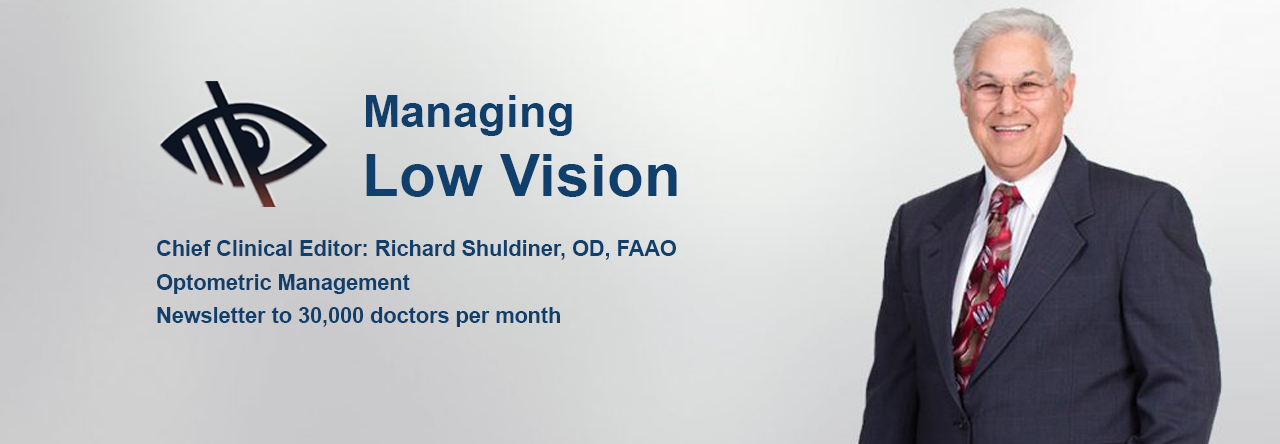October 2020
By Errol Rummel, OD, FAAO, FCOVD, FNORA, FIALVS with Richard J. Shuldiner, OD, FAAO, FIALVS Chief Clinical Editor
Low vision care can be successful even without designing and prescribing advanced optical or electronic technology. I have recently seen 3 patients who told me in my phone interview that no one has been able to help them and that I was their last hope for getting some any vision improvement. Two did better with the simple solutions I recommended. While the third was more complex, at least one of her visual issues was resolved with a simple solution.
Sylvia B., age 60, with mild cataracts, reported seeing fine at distance. Her issue was reading. None of her prescriptions for reading obtained from a few eye doctors worked well. The evaluation demonstrated that, in fact, she did have reasonable distance acuity with her “regular” glasses. Because she complained of near issues, the previous doctor increased her add to 4 diopters over her distance Rx. Much to her surprise, and within the scope of my educated guess, I showed her that there was an approximate 10-inch focal distance for her near add. When material was held at that distance she was reading without hesitation and pleased with her sight.
Unfortunately, none of her recent eye doctors or opticians pointed out the specific focal range of a 4 diopter add. Low vision doctors schedule more time to work with patients and understand the importance of the working distance of the lens. It’s what we do. Because this happens relatively often, I ask patients to bring all their eyeglasses and visual aids to the exam, even if they think they don’t work well. In this case, I was able to solve her problem easily and at very little cost to the patient, as she already had the solution in hand.
William C., age 71, had a history of never doing well with low vision telescope glasses. He told me that when he wore a telescope it just made things larger, but equally blurry. I tested him with 2.2x full diameter prescription telescope glasses and he was unimpressed when looking across the room. I then stood up and held the low vision chart about 10 feet from him and asked him to not look directly at the letters on the line, but to look at my face. Well what a pleasant surprise! Eccentric viewing increased his acuity by 2 lines. While the acuity was still far from normal, he smiled and said that he did not know that looking off the visual center would increase his eyesight. He was amazed and pleased to have his vision easily and inexpensively improved. He left with a smile on his face and was practicing eccentric viewing the whole rest of his way out of the office. I suggested that he might want to reconsider telescopic lenses after he adapted to eccentric viewing.
The 3rd case, Abigail W., age 74, was a post-stroke patient. She was scheduled to see me for side vision loss secondary to aneurysm and a stroke, leaving her blind in her right eye, and in her words, “no vision to the right side of her left eye”. It was causing her to bump into things to her right when walking around.
Since she was intelligent and aware, I took what she said at face value, and assumed a left eye with nasally located, right hemianopsia of her left eye. She then handed me a visual field test performed at her last visit, and I found that in fact the left eye had left hemianopsia. She did not have a right nasal field loss. She did not respond as expected with my standard of care Side Vision Awareness Glasses (SVAG), especially when trying to expand her sight to the left of her left eye.
Given the limited width of her field of view, I decided to test her with Full Field-Side Vision Awareness Glasses (FFSVAG) which are used for those who do not respond to SVAG or have hemianopsia related reading problems. Using an atypical orientation of the FFSVAG before her eyes resulted in a big smile as she realized there was more visual space available for viewing to her right.

Side Vision Awareness Glasses (SVAG)
Invented by Errol Rummel, OD, FAAO, FNORA, FCOVD
rummel.eyecare@yahoo.com
As for her complaint of reading problems with her normal reading glasses, I tried increasing illumination. I find that normal room illumination is inadequate for comfortable reading vision when there is only one half of one eye functioning. With increased illumination her reading ability, which was not due to field loss, improved markedly.
The Full Field Side Vision Awareness Glasses will take time to adapt to. But simply increasing illumination with a gooseneck lamp solved her reading issue immediately.
Low vision care is not always about finding complex, technical devices. These cases demonstrate that simple solutions, sometimes already owned by the patient, can allow the patient to function better.

